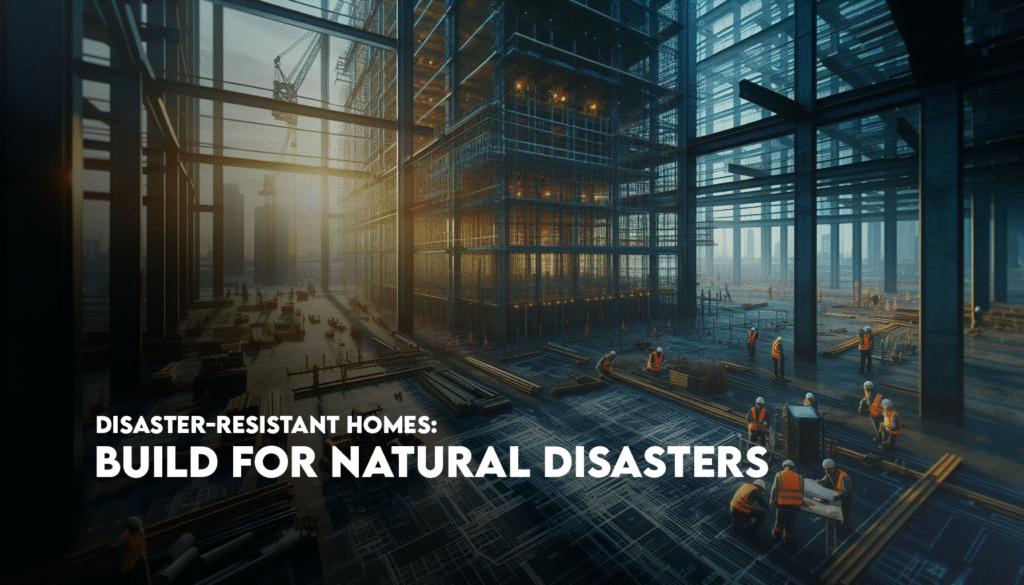Hey there, have you ever thought about what it would be like to ride out a massive earthquake or a howling cyclone right from the comfort of your own home? Not in some sci-fi bunker, but in a place that feels just like any cozy house on the block. It’s not as far-fetched as it sounds. With natural disasters popping up more often these days, thanks to climate change and all builders and architects are stepping up their game. They’re creating disaster-resistant homes that don’t just survive the chaos but keep you and your family safe without sacrificing style or comfort.
Picture this: A family in Japan during the 2011 Tohoku earthquake. Their home shakes like crazy, but thanks to smart earthquake-resistant features, it holds up. No major cracks, no collapse. They walk out unscathed, while neighbors aren’t so lucky. Stories like these show why resilient architecture is a game-changer. It’s all about building for natural disasters in ways that blend safety with everyday living. In this article, we’ll dive into how these designs work, from shaking off earthquakes to batting away cyclones, and even touch on floods and wildfires. We’ll keep it real with examples, tips, and a chatty vibe so it’s easy to follow. Let’s get into it.

Why We Need Disaster-Resilient Architecture Now More Than Ever:
Natural disasters aren’t just headlines, they’re real threats that can turn lives upside down in seconds. Think about hurricanes ripping through coastal towns or earthquakes leveling cities. According to experts, these events are getting fiercer and more frequent. That’s where disaster-resilient architecture comes in. It’s not about making indestructible fortresses; it’s about smart designs that bounce back quickly, minimizing damage and saving lives.
Take resilient construction for natural disaster mitigation, it’s a hot topic because it focuses on prevention rather than just recovery. By using materials and techniques that stand up to Mother Nature’s worst, we can cut down on repair costs and heartbreak. Plus, it’s eco-friendly in the long run, as these builds often incorporate sustainable elements like energy-efficient systems. Who wouldn’t want a home that’s tough on disasters but gentle on the planet?
But here’s the thing: Not every place faces the same risks. In earthquake-prone areas like California or Japan, the focus is on flexibility. For cyclone-heavy spots like Florida or Australia, it’s all about wind resistance. Understanding your local hazards is key to picking the right features. And with trends in resilient architecture evolving, there’s always something new to learn.
Shaking It Off: The Secrets Behind Earthquake-Resistant Homes
Earthquakes can strike without warning, sending shockwaves that test a building’s limits. But earthquake-resistant homes are built to handle the rumble. How? It’s all about absorbing and dissipating that energy instead of fighting it head-on.
Imagine your house as a flexible dancer rather than a stiff statue. Base isolation systems are a prime example, they sit between the foundation and the structure, acting like shock absorbers in a car. During a quake, the building sways gently while the ground shakes wildly below. Japan has nailed this; many of their high-rises use these isolators, and they’ve saved countless lives.
Then there’s reinforced concrete and steel frames. These materials flex without breaking, thanks to strategic bracing. Cross-bracing, like an X-shape in walls, distributes forces evenly. In places like Turkey, after devastating quakes, more builders are adopting these to create earthquake-resistant buildings that last.
Don’t forget shear walls, thick, sturdy panels that resist sideways forces. They’re like the backbone of your home. And for added peace of mind, some designs include damping devices, which are basically giant pendulums or fluid-filled cylinders that counteract vibrations.
Real talk: Retrofitting older homes can make a huge difference too. Adding these features isn’t always cheap, but it’s cheaper than rebuilding from scratch. One story that sticks out is from the 2010 Chile earthquake. Homes with modern resilient designs stood tall, while outdated ones crumbled. It’s a reminder that investing in earthquake resistance pays off big time.
Here are some key features to look for in earthquake-resistant homes:
- Base isolators: Allow the building to move independently from the ground.
- Flexible materials: Like steel beams that bend but don’t snap.
- Bracing systems: Prevent twisting and collapsing.
- Deep foundations: Anchor the structure firmly into stable soil.
By weaving these into the design, architects are making homes that not only survive but thrive post-quake.
Also Read: NZ Smart Homes: Building for a Smarter Future
Battling the Winds: Cyclone-Proof Designs That Stand Firm
Cyclones, hurricanes, whatever you call them, these swirling beasts pack winds that can top 150 mph, tearing roofs off like paper. But cyclone-proof designs are here to say, “Not today.” These homes are engineered to slice through the storm, keeping everything intact.
First off, shape matters. Rounded or aerodynamic roofs reduce wind drag, unlike flat ones that act like sails. In places like the Caribbean, where hurricanes hit hard, builders opt for hip roofs that slope on all sides for better airflow over the structure.
Materials play a starring role too. Impact-resistant windows and doors, made from laminated glass, shrug off flying debris. Reinforced concrete walls and metal straps tying the roof to the foundation ensure nothing lifts off. It’s like strapping down your tent in a gale, but way more high-tech.
Ventilation is clever here, vents that close automatically during high winds prevent pressure buildup inside, which can explode walls outward. And elevated foundations? They keep water out if flooding tags along with the wind.
Let’s chat about a real example: After Cyclone Tracy devastated Darwin, Australia, in 1974, the city rebuilt with stricter codes for cyclone-proof homes. Now, structures there feature bolted connections and wind-rated shutters. When Cyclone Marcus hit in 2018, damage was minimal compared to before. Proof that learning from the past builds a safer future.
If you’re in a windy zone, consider these cyclone-proof tips:
- Install storm shutters or reinforced garage doors.
- Use tie-downs to secure roofs and walls.
- Opt for wind-resistant landscaping, like low trees that won’t become projectiles.
- Regular inspections to ensure everything’s battened down.
These designs aren’t just tough; they’re smart, turning potential disasters into manageable events.
Staying Afloat: Flood-Resistant Buildings in a Watery World
Floods sneak up slowly or crash in fast, but either way, they can drown a home in damage. Flood-resistant buildings flip the script by rising above the risk, literally in some cases.
Elevated structures are a go-to. Homes on stilts or pilings let water flow underneath without touching living spaces. In flood-prone areas like Louisiana, this “raised” design has become standard post-Katrina.
Waterproof materials seal the deal. Think sealed concrete floors and walls treated with barriers that repel moisture. Dry floodproofing uses sealants and shields on lower levels to keep water out, while wet floodproofing allows water in but protects utilities and lets it drain easily.
Smart landscaping helps too, berms and swales direct water away, acting like natural moats. And don’t overlook sump pumps and backflow valves to prevent sewer backups.
A touching story: In Bangladesh, where floods are annual, floating homes made from bamboo and recycled materials bob on the water like boats. Families stay dry and safe, continuing daily life amid rising rivers. It’s resilient architecture at its most adaptive.
Bullet points for flood prep:
- Elevation: Build higher than flood levels.
- Barriers: Flood gates and walls for protection.
- Drainage systems: Ensure quick water runoff.
- Resilient interiors: Use water-resistant furnishings.
With climate change cranking up sea levels, these features are essential for long-term safety.
Beating the Blaze: Wildfire-Resistant Structures
Wildfires rage through dry lands, but wildfire-resistant homes fight back with fire-smart designs. It’s about creating defensible spaces and using non-flammable materials.
Start with the exterior: Metal roofs and siding resist embers better than wood. Tempered glass windows hold up to heat without shattering. And ember-proof vents? They block sneaky sparks from sneaking in.
Landscaping is crucial, clear a 30-foot “defensible space” around the home, free of dry brush. Plant fire-resistant greenery like succulents that hold moisture.
Inside, fire-rated drywall and sprinklers add layers of protection. In California, after massive fires, codes now mandate these for new builds.
Remember the 2018 Camp Fire in Paradise? Some homes survived thanks to these tweaks, while others burned. One family’s story: They rebuilt with wildfire-resistant features, including a gravel perimeter and metal mesh screens. When flames returned, their place stood strong.
Numbered steps for wildfire readiness:
- Assess your property for fire risks.
- Upgrade to fire-resistant materials.
- Create and maintain defensible space.
- Install home sprinkler systems.
These steps turn vulnerable spots into strongholds.
Tech and Innovation: The Future of Building for Natural Disasters
Innovation is turbocharging resilient architecture. Smart sensors detect quakes early, triggering automatic shutoffs for gas and water. 3D-printed homes use durable composites that snap together fast and strong.
Sustainable twists? Solar panels that double as roof reinforcements, or green roofs that absorb floodwater. In disaster relief architecture, modular designs pop up quickly post-event, providing instant shelters.
Looking ahead, AI helps predict risks, guiding where to build tougher. It’s exciting stuff, blending tech with tried-and-true methods.
Real-Life Heroes: Stories of Homes That Defied Disasters
Stories bring this home. In New Zealand, a family’s earthquake-resistant house withstood the 2016 Kaikoura quake, thanks to base isolation. They felt like they were on a boat, not in peril.
Or in Florida, post-Hurricane Michael, cyclone-proof homes with impact glass and strapped roofs emerged unscathed amid ruins. Owners shared how it gave them hope.
These tales show resilient designs aren’t abstract, they save lives and memories.
Your Turn: How to Make Your Home More Disaster-Ready
Ready to toughen up? Start small:
- Get a home assessment for local risks.
- Retrofit with braces or isolators if needed.
- Choose resilient materials for renos.
- Stock an emergency kit and plan.
Chat with local builders about trends in disaster-resilient buildings. It’s empowering to take control.
Wrapping It Up: Building a Safer Tomorrow
From earthquake-resistant homes that flex with the earth to cyclone-proof designs that laugh at winds, building for natural disasters is about smart, safe living. We’ve seen how resilient architecture mitigates risks, heard stories of survival, and got tips to start. In a world of uncertainties, these homes offer certainty: safety and peace. Whether you’re building new or upgrading, embrace these ideas. After all, home should be your sanctuary, no matter what nature throws. Let’s build smarter, together.
